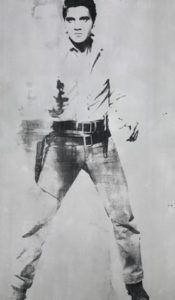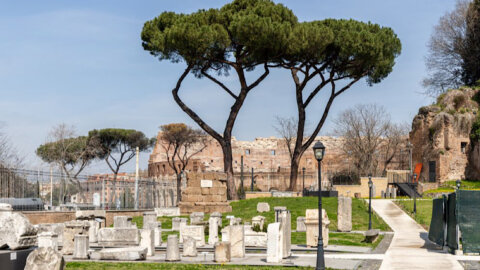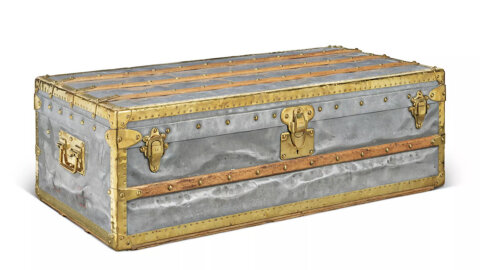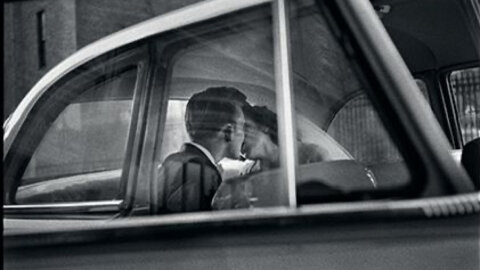The silver Elvis paintings that Warhol made in the summer of 1963 are among the defining icons of his oeuvre. Representing the culmination of several series of celebrity portraits that Warhol made in the early 1960s, these definitive ‘icons of an icon’ rank amongst the most resonant and enduring pictorial statements of his art. Double Elvis pays tribute to a larger-than-life superstar whose international fame brought him the level of celebrity Warhol himself so coveted and admired. Double Elvis unites two of the most venerated men of modern times—the King of Rock ‘n’ Roll and the Prince of Pop.
On May 17 Double Elvis [Ferus Type] will be offered alongside Warhol’s controversial Most Wanted Men, No. 11, John Joseph H., Jr., 1964 (click here for dedicated release), uniting two exceptional canvases that share in the artist’s obsession with American icons of all kinds.
Alex Rotter, Co-Chairman, Post-War and Contemporary Art, remarked: “The King of Rock’n’Roll and the career criminal – icons of icons. These two paintings are very memorable and early examples of Warhol’s profound understanding of fame. Both works, pure black silkscreen on silver and white backgrounds, are the best of Andy Warhol in one auction. We are thrilled to present them together in Christie’s New York sale of Post-War and Contemporary art.”

Loic Gouzer, Co-Chairman, Post-War and Contemporary Art, remarked: “For Warhol, an artist who was obsessed with popular culture and fame, Elvis was a perfect subject. With its monumental size and its shimmering silver surface, this painting encapsulates the glamour and power of Rock and Roll as Warhol saw it. Coming from one of the most ground-breaking exhibitions ever staged for Warhol, this painting holds a paramount place within the pantheon of his celebrity portraits.”
Warhol’s Double Elvis does not portray Elvis the hip-shaking musician but rather Elvis the actor playing a role in the 1960 movie Flaming Star, a liberal-themed Western in which Presley plays Pacer Burton, a half-Kiowa youth torn between two cultures. The painting is a unique variation from a group of portraits of single and multiplied Elvises created especially for Warhol’s second solo exhibition at the Ferus Gallery in Los Angeles—the centre of America’s entertainment industry. Of the twenty-two extant ‘Ferus Type’ Elvis works, eleven are in museum collections, including the canvas Bob Dylan insisted on taking in exchange for his presence in a Warhol film, now housed at the Museum of Modern Art, New York.
Double Elvis features two black screenprinted images of the King on a silver painted ground. A bold, high-contrast figure is accompanied by its ghostly duplicate, collapsing Warhol’s strategy of serialization into a single frame, while also providing an eerie reminder that Presley was a twin, his brother being lost at birth. When the crowd of cloned Elvises were shown at the Ferus Gallery, the paintings were both confrontational and an almost anonymous backdrop.
The Ferus Gallery’s director, Irving Blum, had tried to press on Warhol the idea of a mini-retrospective, writing, “your exhibition should be the most intense and far reaching composite of past work, and the Elvis paintings should be shown in the rear of my gallery area.” Warhol, however, insisted on focusing on his new work and planned to utilize the gallery’s physical space as part of a highly conceptual installation. Before his arrival, Warhol instructed Blum to line the front room with his series of Elvis paintings and the back room with portraits of Elizabeth Taylor.
The repetition of the image created an impression of mass production that had rarely been seen before in an artistic context. The effect was of great interest to artists like Larry Bell, who wrote in response to the exhibition: “It is my opinion that Andy Warhol is an incredibly important artist; he has been able to take painting as we know it, and completely change the frame of reference of painting as we know it, and do it successfully in his own terms. These terms are also terms that we may not understand … In any event, nothing can take away from it the important changes that the work itself has made in the considerations of other artists.”

![Andy Warhold’s Double Elvis [Ferus Type],$ 30 milion](https://www.firstonline.info/wp-content/uploads/2018/04/66AB9B56-1B8F-46DB-8F5E-1962046BDF97.jpeg)



